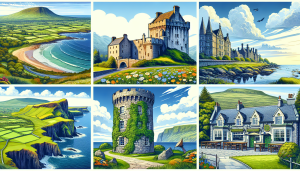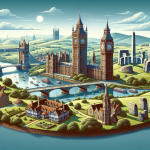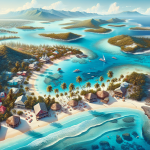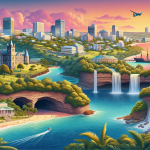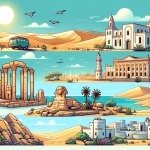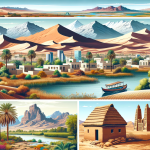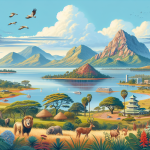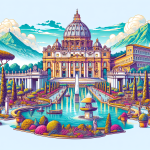Discover the Magic of Ireland: A Journey through the Emerald Isle
When you think of Ireland, images of lush green landscapes, ancient castles, and vibrant cultural traditions likely come to mind. Known as the Emerald Isle, Ireland is a land rich in history, natural beauty, and friendly locals. This captivating destination offers something for every traveler, whether you’re a history buff, a nature enthusiast, or simply looking to experience the warmth and charm of Irish hospitality. In this comprehensive guide, we will delve into the many facets of Ireland, exploring its stunning landscapes, historical sites, and vibrant cities. We will also provide practical travel tips to help you make the most of your trip. From the bustling streets of Dublin to the serene beauty of the Cliffs of Moher, Ireland is a country that will leave you enchanted and eager to return.
Exploring Ireland’s Iconic Landscapes
Ireland’s natural landscapes are nothing short of breathtaking. The country’s diverse terrain includes rolling hills, rugged cliffs, serene lakes, and dense forests. Here are some of the must-see natural wonders in Ireland:
The Cliffs of Moher
The Cliffs of Moher, located on the west coast of Ireland, are one of the country’s most iconic natural attractions. These dramatic cliffs rise over 700 feet above the Atlantic Ocean, offering stunning panoramic views. The cliffs are a popular destination for hikers and nature lovers, with several walking trails that provide different perspectives of this awe-inspiring landscape. Don’t forget to visit the visitor center, which offers informative exhibits about the geology and wildlife of the area.
The Ring of Kerry
The Ring of Kerry is a scenic drive that takes you through some of Ireland’s most picturesque landscapes. This 111-mile route circles the Iveragh Peninsula in County Kerry, passing through charming villages, lush pastures, and rugged coastlines. Highlights of the Ring of Kerry include Killarney National Park, the Gap of Dunloe, and the Skellig Islands. Take your time to explore the many historic sites, hiking trails, and viewpoints along the way.
The Giant’s Causeway
Located in Northern Ireland, the Giant’s Causeway is a UNESCO World Heritage Site and one of the most unique natural wonders in the world. This geological formation consists of about 40,000 interlocking basalt columns, created by an ancient volcanic eruption. According to legend, the causeway was built by the giant Finn McCool. Visitors can explore the site via walking trails and learn more about its history and geology at the visitor center.
Ireland’s Rich History and Culture
Ireland’s history is both fascinating and complex, with a rich tapestry of myths, legends, and historical events. The country’s cultural heritage is evident in its ancient monuments, medieval castles, and vibrant traditions.
Dublin: The Heart of Irish Culture
Dublin, the capital of Ireland, is a city steeped in history and culture. Founded by the Vikings over a thousand years ago, Dublin has evolved into a bustling modern metropolis while retaining its historical charm. Key attractions in Dublin include Trinity College, home to the famous Book of Kells; Dublin Castle, which has played a central role in Ireland’s history; and the Guinness Storehouse, where you can learn about Ireland’s most famous export. Don’t miss the lively Temple Bar district, known for its vibrant nightlife and traditional Irish music.
The Ancient East
Ireland’s Ancient East is a region rich in historical sites and cultural heritage. This area encompasses 5,000 years of history, from the prehistoric passage tombs of Newgrange to the medieval monastic site of Glendalough. Other notable sites include the Rock of Cashel, a dramatic hilltop fortress, and Kilkenny Castle, a beautifully preserved medieval castle. Exploring Ireland’s Ancient East is like stepping back in time, offering a fascinating glimpse into the country’s storied past.
Traditional Irish Music and Dance
Ireland’s cultural heritage is also deeply rooted in its music and dance traditions. Traditional Irish music, characterized by its lively melodies and intricate rhythms, is an integral part of Irish life. You can experience this vibrant art form at pubs and music festivals throughout the country. Irish dance, popularized by shows like “Riverdance,” is another important aspect of the culture. Many towns and villages offer dance performances and workshops where visitors can learn a few steps.
Practical Travel Tips for Visiting Ireland
To ensure a smooth and enjoyable trip to Ireland, it’s important to be prepared. Here are some practical travel tips to help you make the most of your visit:
When to Visit
Ireland has a temperate climate, with mild winters and cool summers. The best time to visit depends on your interests. The summer months (June to August) offer the warmest weather and the longest days, making it ideal for outdoor activities and sightseeing. However, this is also the peak tourist season, so popular attractions can be crowded. Spring (March to May) and autumn (September to November) are great times to visit if you prefer fewer crowds and milder weather. Winter (December to February) is the least popular time to visit, but you can still enjoy cultural events and cozy pubs.
Getting Around
Ireland has a well-developed transportation network, including trains, buses, and rental cars. If you plan to explore the countryside and visit remote areas, renting a car is the most convenient option. However, be prepared for narrow, winding roads and driving on the left side. Public transportation is a good alternative for city travel and popular tourist routes. The train network connects major cities and towns, while buses reach more remote areas.
Accommodation
Ireland offers a wide range of accommodation options, from luxury hotels and charming bed-and-breakfasts to budget hostels and self-catering cottages. For an authentic Irish experience, consider staying in a traditional bed-and-breakfast, where you can enjoy the hospitality of local hosts and a hearty Irish breakfast. Booking in advance is recommended, especially during peak tourist season.
Experiencing Irish Cuisine
Irish cuisine has evolved significantly in recent years, with a focus on fresh, locally sourced ingredients and innovative culinary techniques. Here are some traditional and modern Irish dishes that you should try during your visit:
Traditional Irish Dishes
- Irish Stew: A hearty and comforting dish made with lamb or beef, potatoes, carrots, and onions.
- Boxty: A traditional Irish potato pancake, often served with butter and sour cream.
- Colcannon: A creamy mashed potato dish mixed with cabbage or kale.
- Soda Bread: A dense and flavorful bread made with baking soda instead of yeast.
Modern Irish Cuisine
Ireland’s culinary scene has embraced modern influences and techniques, resulting in a vibrant and diverse food culture. Many restaurants focus on farm-to-table dining, using fresh, locally sourced ingredients. Seafood is particularly popular, with dishes like fresh oysters, smoked salmon, and seafood chowder. Don’t miss the opportunity to dine at one of Ireland’s many acclaimed restaurants, which offer everything from fine dining to casual pub fare.
Exploring Ireland’s Vibrant Cities
In addition to Dublin, Ireland is home to several other vibrant cities, each with its own unique character and attractions.
Galway
Galway, located on the west coast of Ireland, is known for its artistic and bohemian vibe. The city is a hub for traditional Irish music and hosts numerous festivals throughout the year, including the Galway International Arts Festival and the Galway Races. Stroll through the charming streets of the Latin Quarter, visit the historic Galway Cathedral, and enjoy the lively atmosphere of Eyre Square.
Cork
Cork, Ireland’s second-largest city, is located in the south of the country. Known for its lively food scene, Cork is home to the famous English Market, where you can sample a wide variety of local produce and artisanal foods. Other attractions in Cork include the historic Cork City Gaol, the beautiful Fitzgerald Park, and the vibrant St. Patrick’s Street. Cork is also a gateway to the scenic landscapes of County Cork and the picturesque town of Kinsale.
Limerick
Limerick, located in the midwest of Ireland, is a city with a rich history and a thriving cultural scene. Visit King John’s Castle, a medieval fortress that offers interactive exhibits and stunning views of the River Shannon. The Hunt Museum houses an impressive collection of art and antiquities, while the Limerick City Gallery of Art showcases contemporary Irish art. Limerick is also known for its lively pubs and music venues.
Outdoor Activities and Adventures in Ireland
Ireland’s diverse landscapes provide ample opportunities for outdoor activities and adventures. Whether you’re an avid hiker, a water sports enthusiast, or simply enjoy exploring the great outdoors, Ireland has something to offer.
Hiking and Walking Trails
Ireland is a hiker’s paradise, with numerous trails that cater to all levels of experience. Some popular hiking destinations include:
- The Wicklow Way: A 79-mile long-distance trail that takes you through the scenic Wicklow Mountains, offering stunning views and diverse landscapes.
- The Dingle Way: A 111-mile circular trail that explores the Dingle Peninsula, passing through charming villages, rugged coastlines, and ancient archaeological sites.
- The Causeway Coast Way: A 33-mile trail that follows the dramatic coastline of Northern Ireland, offering views of the Giant’s Causeway, Dunluce Castle, and the Carrick-a-Rede Rope Bridge.
Water Sports and Activities
Ireland’s coastline and numerous lakes provide a playground for water sports enthusiasts. Some popular water activities include:
- Surfing: Ireland has some of the best surfing spots in Europe, with popular locations including Bundoran in County Donegal, Lahinch in County Clare, and Tramore in County Waterford.
- Kayaking and Canoeing: Explore Ireland’s rivers, lakes, and coastline by kayak or canoe. The Shannon River and Lough Corrib are popular destinations for paddling adventures.
- Sailing and Boating: Ireland’s coastal waters and inland waterways offer excellent opportunities for sailing and boating. The West Cork coastline and the Shannon-Erne Waterway are particularly popular among sailors.
Golf
Ireland is a golfer’s paradise, with over 400 golf courses to choose from, including world-renowned links courses. Some of the top golf destinations in Ireland include:
- Ballybunion Golf Club: Located in County Kerry, Ballybunion is one of Ireland’s most famous golf courses, known for its challenging links and stunning coastal views.
- Royal County Down Golf Club: Situated in Northern Ireland, Royal County Down is consistently ranked among the best golf courses in the world, offering a challenging layout and breathtaking scenery.
- Portmarnock Golf Club: Located just outside Dublin, Portmarnock is a historic links course that has hosted numerous championships and offers a true test of golfing skill.
Embracing Irish Festivals and Events
Ireland is known for its lively festivals and events, which celebrate everything from music and literature to food and sports. Here are some of the most popular festivals to experience during your visit:
St. Patrick’s Day
St. Patrick’s Day, celebrated on March 17th, is Ireland’s most famous holiday. The festivities include parades, music, dancing, and plenty of green attire. Dublin hosts one of the largest St. Patrick’s Day parades in the world, drawing visitors from around the globe to join in the celebration.
Galway International Arts Festival
The Galway International Arts Festival, held in July, is one of Ireland’s premier cultural events. The festival features a diverse program of visual arts, theater, music, dance, and street performances. It’s a fantastic opportunity to experience the vibrant arts scene in Galway and enjoy performances by both local and international artists.
Cork Jazz Festival
The Cork Jazz Festival, held in October, is one of Europe’s top jazz festivals. The event attracts renowned jazz musicians from around the world and features performances in various venues throughout the city. Whether you’re a jazz aficionado or simply enjoy live music, the Cork Jazz Festival is a must-visit event.
Conclusion
Ireland is a captivating destination that offers a wealth of experiences for travelers. From its stunning landscapes and rich history to its vibrant cities and warm hospitality, the Emerald Isle has something for everyone. Whether you’re exploring ancient castles, hiking along rugged coastlines, enjoying traditional music in a cozy pub, or savoring delicious Irish cuisine, you’ll find that Ireland’s charm and beauty are truly enchanting. So pack your bags, embrace the spirit of adventure, and get ready to discover the magic of Ireland.
For more travel inspiration and tips, visit Lonely Planet’s Ireland Travel Guide.
